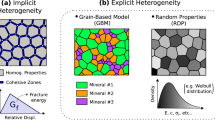Abstract
The synergistic effects of microdamage due to repeated loading in Asphalt-Aggregate system at a high temperature (40°C) and moisture damage analysis based on surface free energy theory are presented in this paper. The introduction of moisture in either a liquid or vapor state during cyclic loading may well be more damaging than simply moisture conditioning an asphalt concrete sample prior to testing. This difference may be due to the presence of a dynamic “network” of adhesive fracture, which potentially provides a channel for moisture movement within the sample. The percentage of the surface area of aggregate that has been exposed to water was used as a significant index to quantify the level of adhesive fracture. This index is calculated with the surface free energies of aggregate and asphalt which are measured by two methods, the universal gas adsorption and the Wilhelmy plate, respectively. The relation between the percentage of the surface area of the aggregate exposed to water and the number of cycles of loading assists in quantifying adhesive fracture in the asphalt-aggregate mixture.
Similar content being viewed by others
References
Adamson, Arthur W. (1997) “Physical Chemistry of Surfaces.” 6th, pp. 8–40.
Carroll, B.J. (1993) “Direct Measurement of the Contact Angle on Plates and on Thin Fibres: some Theoretical Aspects.” Contact Angle, Wettability and Adhesion, pp. 235–246.
Chan, C.M. (1994) “Polymer Surface Modification and Characterization.” pp. 35–63.
Cheng, D.X., Little, D.N., and Holste, J.C. (2002) “Use of Surface Free Energy Properties of the Asphalt-aggregate System to Predict Moisture Damage Potential.” AAPT.
Cheng, D.X., Little, D.N., Lytton, R.L., and Holste, J.C. (2001) “Surface Free Energy Measurement of Aggregates and its Application on Adhesion and Moisture Damage of Asphalt-Aggregate System.”Annual Symposium Proceedings of International Center for Aggregate Research, 9th.
Curtis, C.W., Ensley, K., and Epps, J. (1993) “Fundamental Properties of Asphalt-Aggregate Interactions Including Adhesion and Absorption.” SHRO-A-341, p. 8.
Curtis, C.W., Lytton, R.L., and Brannan, C.J. (1992) “Influence of Aggregate Chemistry on the Adsorption and Desorption of Asphalt.”Transportation Research Record, No 1362, pp. 1–9.
Elphingstone, G.M. (1997) “Adhesion and Cohesion in Asphalt-aggregate Systems.” Ph.D. dissertation of Texas A&M University.
Fowkes, F.M. (1962) “Determination of Interfacial Tensions, Contact Angles, and Dispersion Forces in Surfaces by Assuming Additivity of Intermolecular Interactions in Surfaces.”Journal of Physical Chemistry, Vol. 66, p. 382.
Good, R.J. (1992) “Contact-Angle, Wetting, and Adhesion: A Critical Review.”Journal of Adhesion Science and Technology, Vol. 6, No. 12, pp. 1269–1302.
Good, R.J. and Can Oss, C.J. (1991) “The Modern Theory of Contact Angles and the Hydrogen Bond Components of Surface Energies.” Modern Approach to Wettability: Theory and Application, Plenum Press, New Your.
Lange, N.A. (1967) “Handbook of Chemistry.” 10th.
Li, W. (1997) “The Measurement of Surface Free Energy for Aggregates SHAP RB.” Final Report of Cahn Balance Thermogravimetry Gas Adsorption Experiments.
Little, D.N., Lytton, R.L., Williams, D., and Kim, Y.R. (1999) “An Analysis of the Mechanism of Microdamage Healing based on the Application of Micromechanics first Principles of Fracture and Healing.”The Association of Asphalt Paving Technologists, Vol. 68.
Lytton, R.L. (2001a) CVEN Course Notes, Department of Civil Engineering, Texas A&M University, College Station, Texas.
Lytton, R.L. (2001b) “Personal Communication.” Department of Civil Engineering, Texas A&M University, College Station, TX.
Lytton, R.L., Kim, Y.R., Glover, C., Schapery, R., Masad, E., Lesueur, D., and Coletti, D. (2002) “Task 14. Crack Phenomenology: Formation and Healing.” Quarterly Technical Report, Western Research Institute, pp. 127–154.
Maugis, D. (1999)Contact, Adhesion and Rupture of Elastic Solids, Springer, pp. 3–12.
Padday, J.F. (1993)Spreading, Wetting, and Contact Angles, Contact Angle, Wettability and Adhesion, pp. 97–108.
Terrel, R.L. (1994) “Water Sensitivity of Asphalt-Aggregate Mixes.” SHRO-A-403.
Yang, X.F. (1995) “Equilibrium Contact Angle and Intrinsic Wetting Hysteresis.”Applied Physics Letters, Vol. 67, No. 15, pp. 2249–2251.
Zettlemoyer, A.C. (1969)Hydrophobic Surfaces, Academic Press New York and London, p. 8.
Author information
Authors and Affiliations
Corresponding author
Additional information
Thi manuscript for this paper was submitted for review on June 18, 2002.
Rights and permissions
About this article
Cite this article
Kim, SH., Jeong, JH. & Kim, N. Use of surface free energy properties to predict moisture damage potential of Asphalt concrete mixture in cyclic loading condition. KSCE J Civ Eng 7, 381–387 (2003). https://doi.org/10.1007/BF02895836
Issue Date:
DOI: https://doi.org/10.1007/BF02895836




